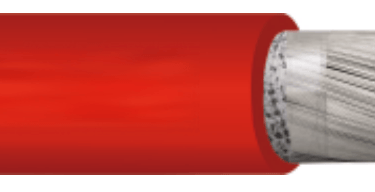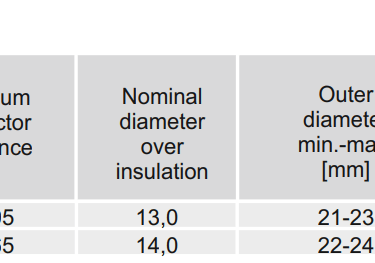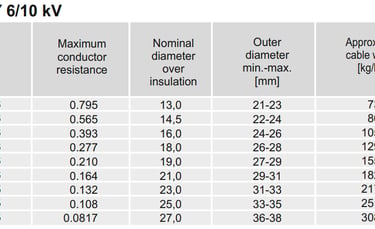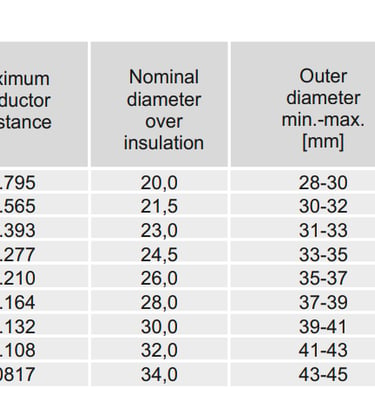📞+86 153 7530 2641 📧 hongjing.Wang@feichuncables.com

High-Flexibility (N)TMCGCW11Y Medium-Voltage Screened Single Core Cable for Energy Chains and Offshore Power Systems: Small Bending Radius Connection Solutions
Discover the (N)TMCGCW11Y high-flexibility medium-voltage screened single core cable ideal for small bending radius connections in switch-gear, transformer houses, offshore power systems, and shore power for container vessels. Learn about temperature range –40°C to 90°C, UV and oil resistance, energy chain compatibility, and DIN VDE/UL certifications.
hongjing.Wang@Feichun
8/20/202511 min read


Introduction
Overview of (N)TMCGCW11Y Cable
The (N)TMCGCW11Y represents a breakthrough in medium-voltage cable technology, specifically engineered for applications requiring exceptional flexibility and reliability in challenging environments. This high-performance screened single core cable, manufactured in accordance with DIN VDE 0250-813 standards and CPR 305/2011 regulations, addresses the growing demand for compact, durable power transmission solutions in modern electrical installations.
Designed with advanced EPR (Ethylene Propylene Rubber) insulation compounds and featuring a thermoplastic polyether-based polyurethane outer sheath, the (N)TMCGCW11Y cable delivers superior mechanical and electrical characteristics. Its innovative construction enables unprecedented flexibility while maintaining robust electrical performance across voltage ranges from 3.6/6 kV to 18/30 kV, making it an ideal choice for space-constrained installations and dynamic applications.
Importance of Flexible Medium-Voltage Cables in Modern Electrical Installations
As industrial automation and offshore energy systems continue to evolve, the demand for cables that can withstand continuous movement, extreme temperatures, and harsh environmental conditions has intensified dramatically. Traditional rigid cables often fail in applications requiring frequent flexing, small bending radii, or exposure to oils, moisture, and UV radiation. The (N)TMCGCW11Y cable addresses these limitations by combining advanced materials science with precision engineering to deliver reliable power transmission in the most demanding scenarios.
Modern electrical installations, particularly in offshore environments, port facilities, and automated industrial systems, require cables that can maintain their electrical integrity while adapting to mechanical stresses and environmental challenges. The (N)TMCGCW11Y's unique design philosophy prioritizes both electrical performance and mechanical durability, establishing new benchmarks for flexible medium-voltage cable solutions.




Key Features and Technical Specifications
Conductor and Insulation Design
The (N)TMCGCW11Y features a meticulously engineered conductor system utilizing tinned copper wires with fine stranding classified as Class 5 according to DIN EN/IEC 60228 standards. This construction ensures optimal current distribution while maximizing flexibility and resistance to mechanical stress. The tinned copper stranding provides enhanced corrosion resistance, particularly crucial for offshore and marine applications where salt air exposure is inevitable.
The insulation system incorporates a sophisticated three-layer design beginning with an inner semi-conductive stress control layer that ensures uniform electric field distribution. The primary insulation consists of an EPR compound with enhanced electrical and mechanical characteristics based on DIN VDE 0207-20 specifications. This advanced formulation delivers exceptional dielectric strength while maintaining flexibility across the entire operating temperature range. An outer semi-conductive insulation shield layer completes the insulation system, providing additional protection against electrical stress and ensuring consistent performance.
Screened Single Core Construction
The cable's screened single core construction features a concentric ground conductor composed of tinned copper wire strands, providing approximately 85% coverage based on DIN VDE 0250-1 specifications. This comprehensive screening system effectively minimizes electromagnetic interference while ensuring reliable ground path continuity. The concentric design maintains consistent impedance characteristics and provides robust protection against electrical noise, making it particularly suitable for sensitive electronic equipment installations.
The screening system's high coverage percentage ensures excellent EMC (Electromagnetic Compatibility) performance, crucial for applications in environments with multiple electrical systems operating simultaneously. The tinned copper construction of the screening conductor provides long-term corrosion resistance and maintains low resistance characteristics throughout the cable's operational lifetime.
Thermoplastic Polyether Polyurethane Outer Sheath
The outer sheath utilizes advanced thermoplastic polyether-based polyurethane conforming to EN 50363-10-2 specifications, delivering exceptional mechanical characteristics combined with superior environmental resistance. This innovative sheath material provides outstanding oil resistance according to EN 60811-404 standards, making it ideal for industrial environments where hydrocarbon exposure is common.
The polyurethane formulation incorporates flame-retardant properties meeting EN 60332-1-2 requirements, ensuring fire safety compliance without compromising mechanical performance. The distinctive red color with inkjet marking provides clear identification and traceability, essential for complex installation environments. The sheath's formulation enables unrestricted indoor and outdoor use while providing resistance to moisture, ozone, and UV radiation.
Temperature and Mechanical Performance
The (N)TMCGCW11Y demonstrates exceptional thermal performance with an ambient temperature range of -50°C to 90°C for fixed installations and -40°C to 90°C for flexible operations. The maximum permissible conductor temperature of 90°C ensures optimal current-carrying capacity while maintaining insulation integrity. During short-circuit conditions, the cable can withstand conductor temperatures up to 200°C without permanent damage.
Mechanical specifications include a maximum tensile load of 15 N/mm² per conductor, enabling reliable performance under mechanical stress. The bending radius requirements are optimized for space-constrained installations: ≥6 × outer diameter for fixed installations and ≥8 × outer diameter for free-moving applications. These specifications enable installation in compact switch-gear and transformer houses while maintaining long-term reliability.




Application Scenarios
Short-Length Connections in Switchgear and Transformer Houses
The (N)TMCGCW11Y cable excels in short-length connection applications within switchgear and transformer houses where space constraints demand minimal bending radii. Traditional cables often require significant clearance for proper installation, limiting design flexibility and increasing installation costs. The (N)TMCGCW11Y's superior flexibility enables routing through tight spaces while maintaining electrical performance and mechanical integrity.
In transformer houses, the cable's oil resistance proves invaluable, as accidental exposure to transformer fluids does not compromise cable performance. The UV-resistant outer sheath ensures long-term reliability even in installations with exposure to artificial lighting sources. The flame-retardant properties provide additional safety margins in these critical electrical installations.
Slow-Moving Offshore Power Systems
Offshore power systems present unique challenges requiring cables capable of withstanding marine environments while maintaining flexibility for dynamic applications. The (N)TMCGCW11Y addresses these requirements through its comprehensive environmental resistance and mechanical durability.
Energy Chain Integration: The cable's design specifically accommodates energy chain applications with movement speeds ranging from 70-240 m/min for crane installations. The flexible construction maintains electrical continuity during continuous flexing cycles, while the polyurethane sheath resists abrasion and environmental degradation. The concentric screening ensures EMC compliance even during dynamic operation.
Reeling Operations: For reeling drum applications, the cable's bending radius characteristics and tensile strength specifications enable reliable operation through countless winding and unwinding cycles. The EPR insulation maintains its properties despite repeated mechanical stress, ensuring consistent electrical performance throughout the operational lifetime.
Shore Power Systems for Container Vessels and Port Cranes
Shore power applications require cables capable of delivering reliable electrical connections between land-based power sources and vessels or mobile equipment. The (N)TMCGCW11Y's water resistance capabilities, including submersion protection up to 10 bar pressure (protection class AD8), make it ideal for these applications.
Port crane installations benefit from the cable's movement speed capabilities and mechanical durability. The 6 m/min movement speed specification for shore-power systems ensures compatibility with standard connection procedures, while the enhanced mechanical characteristics accommodate the dynamic loading associated with vessel movement and crane operations.




Installation and Operational Advantages
Flexible Operation at –40°C to 90°C
The (N)TMCGCW11Y's wide operating temperature range provides exceptional versatility across diverse climatic conditions. In arctic offshore installations, the cable maintains flexibility and electrical performance at temperatures as low as -40°C, while tropical and desert environments pose no challenges with the 90°C maximum operating temperature. This thermal performance eliminates the need for heating systems or special climate control measures in many installations.
The thermal stability of the EPR insulation ensures consistent dielectric properties across the entire temperature range, maintaining power quality and system reliability regardless of environmental conditions. The polyurethane sheath retains its mechanical properties and environmental resistance throughout temperature cycling, providing long-term durability.
High UV, Oil, and Moisture Resistance
Environmental resistance represents a critical advantage of the (N)TMCGCW11Y design. The polyurethane outer sheath provides outstanding resistance to hydrocarbon oils commonly found in industrial and marine environments. This resistance prevents sheath degradation and maintains cable integrity even during prolonged exposure to petroleum products, hydraulic fluids, and lubricants.
UV resistance enables unrestricted outdoor installation without concerns about photodegradation. The cable can withstand direct sunlight exposure without protective covering, reducing installation costs and maintenance requirements. Moisture resistance, including the ability to operate when completely submerged under pressures up to 10 bar, provides exceptional reliability in marine and wet industrial environments.
Drag Chain Compatibility and Movement Speeds
The cable's mechanical design specifically addresses drag chain applications with optimized flexibility and durability characteristics. The fine-stranded conductor construction and flexible insulation system minimize internal stress during repeated bending cycles, while the polyurethane sheath provides excellent abrasion resistance against chain guides and supports.
Movement speed capabilities accommodate various application requirements, from slow shore-power connections at 6 m/min to high-speed crane operations up to 240 m/min. This versatility enables standardization on a single cable type across multiple applications, reducing inventory requirements and simplifying maintenance procedures.
Custom Cross-Sections and Core Configurations
Recognizing that standard configurations may not meet all application requirements, the manufacturer offers custom cross-sections and core configurations upon request. This flexibility enables optimization for specific voltage, current, and mechanical requirements while maintaining the cable's fundamental performance characteristics.
Custom configurations can address unique installation constraints, special current-carrying requirements, or specific mechanical performance needs. The manufacturing capability to produce tailored solutions ensures optimal performance across diverse applications while maintaining compliance with relevant standards.


Compliance and Certifications
DIN VDE 0250-813, EN 60811-404, EN 50363-10-2 Standards
The (N)TMCGCW11Y demonstrates comprehensive compliance with European electrical standards, ensuring compatibility with continental electrical systems and installation practices. DIN VDE 0250-813 compliance guarantees proper medium-voltage cable construction and performance characteristics, while EN 60811-404 certification confirms oil resistance properties essential for industrial applications.
EN 50363-10-2 compliance for the outer sheath ensures consistent material properties and performance characteristics. These certifications provide assurance of quality and reliability while enabling specification by engineers familiar with European cable standards.
CPR305/2011 Fire Safety Rating
Construction Products Regulation 305/2011 compliance ensures fire safety performance meeting European building and installation requirements. This certification is particularly important for installations in occupied buildings, offshore platforms, and other environments where fire safety represents a critical concern.
The flame-retardant properties of the polyurethane sheath, combined with the overall cable construction, provide fire safety performance without compromising mechanical or electrical characteristics. This balance enables installation in fire-sensitive environments while maintaining operational reliability.
UL Certificate No. UL-US-2322575-0/E524140
UL certification expands the cable's applicability to North American installations, providing recognition under US and Canadian electrical codes. Certificate number UL-US-2322575-0/E524140-20230602 demonstrates current compliance with UL standards and ensures acceptability for installations requiring UL-listed components.
This dual certification approach enables global deployment while ensuring local code compliance, reducing engineering time and certification costs for international projects.
Selection Guide and Ordering Information
Rated Voltage Options (3.6/6 kV to 18/30 kV)
The (N)TMCGCW11Y is available across multiple voltage ratings to accommodate various system requirements. The 3.6/6 kV rating serves low-voltage distribution applications, while 6/10 kV configurations address medium-voltage distribution requirements. For transmission applications and high-voltage systems, 18/30 kV ratings provide appropriate electrical performance.
Maximum permissible operating voltages vary by rating and system type, with AC systems accommodating higher voltages than DC installations. For example, the 18/30 kV rating supports up to 20.8/36 kV in AC systems and 27/54 kV in DC applications, providing flexibility for diverse electrical system designs.
Conductor Size, Outer Diameter, and Current-Carrying Capacity
Conductor sizes range from 25 mm² to 240 mm², accommodating current requirements from 135A to 607A based on IEC 60364-5-52 calculations. These ratings assume 90°C conductor temperature, 30°C ambient temperature, and free air installation using method F with three loaded conductors in trefoil configuration.
Outer diameters vary by voltage rating and conductor size, with 6/10 kV cables ranging from 21-23 mm for 25 mm² conductors to 36-38 mm for 240 mm² conductors. The 18/30 kV series requires larger diameters due to increased insulation thickness, ranging from 28-30 mm to 43-45 mm for equivalent conductor sizes.
Cable weights increase with conductor size and voltage rating, from approximately 715 kg/km for the smallest 3.6/6 kV configuration to 3640 kg/km for the largest 18/30 kV variant. These specifications enable accurate load calculations for cable tray and support structure design.
Special Requests: Custom Core Counts and Cross-Sections
Beyond standard single-core configurations, the manufacturer accommodates requests for alternative core counts and cross-sectional areas. Multi-core configurations may be available for specific applications, while intermediate conductor sizes can address precise current-carrying requirements.
Custom configurations require detailed specification of electrical, mechanical, and environmental requirements to ensure optimal performance. Lead times for custom cables typically exceed standard products, necessitating early identification of special requirements during project planning phases.
Common Questions and Troubleshooting
Q: Can the (N)TMCGCW11Y cable be used in drag chain applications with frequent reversing motion?
A: Yes, the cable is specifically designed for drag chain applications. The fine-stranded Class 5 conductor and flexible EPR insulation system can handle frequent reversing motions. However, ensure the bending radius stays above 8× outer diameter for moving applications, and verify that movement speeds don't exceed the specified limits (6 m/min for shore-power systems, 70-240 m/min for crane applications).
Q: What happens if the cable is accidentally exposed to transformer oil or hydraulic fluids?
A: The thermoplastic polyether polyurethane outer sheath provides excellent oil resistance according to EN 60811-404 standards. Brief or extended exposure to most industrial oils and hydraulic fluids will not damage the cable. However, for continuous submersion in oils, verify compatibility with the specific fluid chemistry and consider additional protective measures if required.
Q: How should installation be approached in areas with extreme temperature variations?
A: The cable operates reliably from -40°C to 90°C in flexible applications. During installation in extreme cold, allow the cable to gradually warm before flexing to prevent temporary stiffening. In hot environments, ensure adequate ventilation around the cable to prevent exceeding the 90°C conductor temperature limit. Consider derating current capacity if ambient temperatures consistently exceed 30°C.
Q: Is additional EMC shielding required for sensitive electronic equipment installations?
A: The concentric ground conductor provides approximately 85% screening coverage, which is typically sufficient for most industrial applications. For installations near highly sensitive electronic equipment, verify EMC requirements and consider additional shielding or cable routing techniques if necessary. The screening effectiveness is maintained even during flexible operation.
Q: What maintenance procedures are recommended for moving cable installations?
A: Regularly inspect cable routing for proper bend radius compliance and signs of mechanical wear, particularly at entry and exit points from drag chains. Check screening conductor continuity and insulation resistance annually or per facility maintenance schedules. Replace cables showing signs of outer sheath cracking, conductor exposure, or reduced flexibility. Ensure drag chain guides remain properly lubricated and aligned to minimize cable abrasion.
Conclusion
Summary of (N)TMCGCW11Y Application Benefits
The (N)TMCGCW11Y high-flexibility medium-voltage screened single core cable represents a significant advancement in power transmission technology for demanding applications. Its innovative combination of advanced materials, precision engineering, and comprehensive certifications delivers reliable performance across diverse environments and applications.
Key benefits include exceptional flexibility enabling small bending radius installations, comprehensive environmental resistance for offshore and industrial applications, wide temperature range operation, and drag chain compatibility for dynamic installations. The cable's ability to maintain electrical performance while withstanding mechanical stress makes it an ideal solution for modern automated systems, offshore power installations, and space-constrained electrical facilities.
The extensive certification portfolio, including DIN VDE, EN, CPR, and UL approvals, ensures global applicability while meeting local code requirements. Custom configuration availability provides flexibility to address unique application requirements while maintaining proven performance characteristics.
Contact and Technical Support Information
For detailed technical specifications, application engineering support, or custom configuration requirements, contact the manufacturer's technical support team. Experienced application engineers can provide guidance on cable selection, installation procedures, and optimization for specific environmental or mechanical requirements.
The manufacturer reserves the right to modify specifications without prior notification, ensuring continuous improvement in cable performance and manufacturing processes. For the most current specifications and availability information, consult the latest technical documentation or contact technical support directly.
Through its combination of advanced materials science, precision manufacturing, and comprehensive testing, the (N)TMCGCW11Y establishes new benchmarks for flexible medium-voltage cable performance in challenging applications. Its proven reliability in offshore environments, industrial installations, and dynamic applications makes it an essential component for modern electrical infrastructure requiring both performance and durability.
How to Reach Us
Get in Touch
SiteMap
Product Catalogue
Reeling Cable
Festoon Cable
Shore Power Cable




Scan to add us on WeChat
